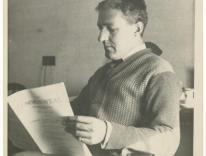Name a prominent American Catholic in public life whose Catholicism is central to the views he promotes in the public sphere. My guess is that did not take you too long. Now, just as quickly, name a prominent American Catholic artist—you choose the medium—who makes it clear that her faith informs her art. Time’s up. Now, of course, there are such artists, but what does it say about the cultural life of the church that it is easy to think of prominent Catholic politicians and pundits and journalists but it is difficult to think of prominent Catholic painters or sculptors or novelists or musicians? Expanding the circle to other Christians would only help matters a little.
Gregory Wolfe does not pose exactly this question in his fine book Beauty Will Save the World: Recovering the Human in an Ideological Age, but his meditations left me thinking just that. Wolfe has written an engaging account of his own shift from a recent graduate of Hillsdale College and proud member of the Reagan revolution to the founder and editor of the excellent quarterly journal Image, which brings contemporary arts into conversation with Christianity. (Wolfe recounted part of this story in “I Was a Teenage Conservative,” Commonweal, March 9, 2001.) If you agree with Wolfe, as I do, that although “art in itself cannot save a single soul...the imagination helps us to see and speak the truth,” then it is difficult to overstate the importance of Wolfe’s project. This project reminds us of the deep tradition of Christian humanism that seeks to engage the culture rather than battle it. Christian humanism, according to Wolfe, is “the effort to achieve a new synthesis between the condition of the world around us and the unique ways in which grace can speak to that condition.” The aim is to encounter the world as it is through the art it produces.
Wolfe makes the argument for Christian humanism throughout a series of essays, which are divided into five sections. He begins by laying out his understanding of the need for Christian humanism today. From there he engages Christian writers as varied as Flannery O’Connor, Gerard Manley Hopkins, Evelyn Waugh, Geoffrey Hill, Wendell Berry, and Larry Woiwode. He then turns to the painting of Fred Folsom, Mary McCleary, and Makoto Fujimura. In conclusion, he tackles a group of intellectuals and polemicists, including Russell Kirk and Malcolm Muggeridge.
Wolfe argues that like much of the public at large, Christians are “alienated from the world of contemporary art.” Contemporary Christianity “has abdicated its stewardship of culture and, more important, has frequently chosen ideology rather than imagination when approaching the challenges of the present.” Ideology is not a mark of Christian confidence; it is a mark of Christian fear. Careful assimilation, however, “constitutes the heart of the Christian humanist’s vision.” Assimilation is key. Because “Christian humanists believe that whatever is good, true, and beautiful is part of God’s design, they have the confidence that their faith can assimilate the works of culture.”
Yet Wolfe is no starry-eyed optimist ready to baptize any form of contemporary art in an effort to somehow keep Christianity “relevant.” Just as, in St. Athanasius’s phrase, in the Incarnation God became a human being so that human beings could become gods, the Christian humanist takes the culture he or she sees and transforms it to reflect the glory of God. Etienne Gilson, for example, achieved precisely this in arguing that abstract painting, which does not imitate reality but creates art for its own sake, is analogous to God’s creative work in creation.
Wolfe does more than champion the work of Christian humanism; he enacts it. I have a simple rule for judging the value of literary and artistic criticism. If a critic makes me want to read a novel or see an opera or painting, I judge the criticism useful. If he or she makes me want to read all that the novelist has written, I will keep an eye on the critic’s other recommendations. I know I have come across an important critic, however, if he or she convinces me that reading a particular novel will help open the world for me in a new way. Wolfe clearly fits the latter category.
I cannot do justice to all Wolfe’s essays in this space, so I will focus on two, one about a contemporary artist and the other about one of Wolfe’s teachers. I knew nothing of Fred Folsom’s painting before reading Wolfe’s account of it. And, I must admit, contemporary realist painting does not normally pique my interest. But Wolfe’s analysis of the power of Folsom’s Last Call (at the Shepherd Park Go-Go Club) transformed a painting whose ostensible subject is a strip club into a meditation on “the paradoxical ways in which grace interacts with nature, and an awareness that our restlessness and longings are manifestations of our hunger for God.” Although Wolfe thinks of himself primarily as a literary critic, the essays on Folsom, McCleary, and Fujimara show him to be a deft interpreter of figurative artists and their faith.
The most personal essay in this collection is on Gerhardt Niemeyer, Wolfe’s former college professor. Wolfe praises Niemeyer’s scholarship and his teaching. In fact, Niemeyer’s philosophy served as inspiration for the founding of Image. Great art and literature, Niemeyer taught Wolfe, “provide diagnostic insight into social and cultural decadence.” More important, they capture “positive experiences” that provide a basis for genuine spiritual renewal.
It was Dostoevsky who said “beauty will save the world,” and if this renewal comes about, it will happen because “the greatest and most enduring creations of culture...combine to train our sensibilities so that we can discern the spirits in trying times.” Wolfe’s book and his editorial work at Image are a testament to such discernment. He has made it easier for me to name artists whose faith informs their work, and he has offered reasons to hope that such artists will be nurtured in the Christian community.


